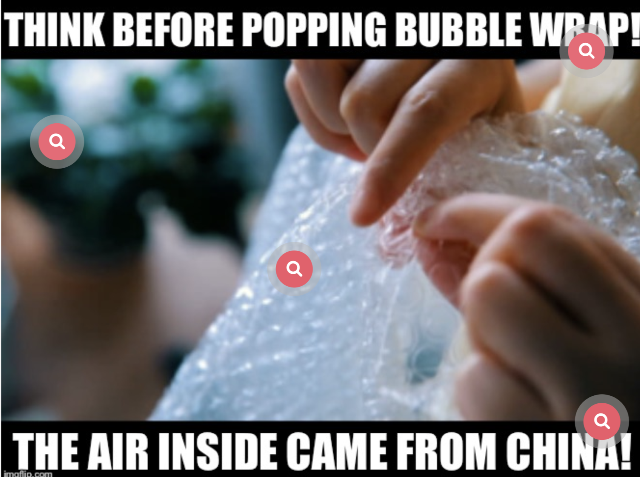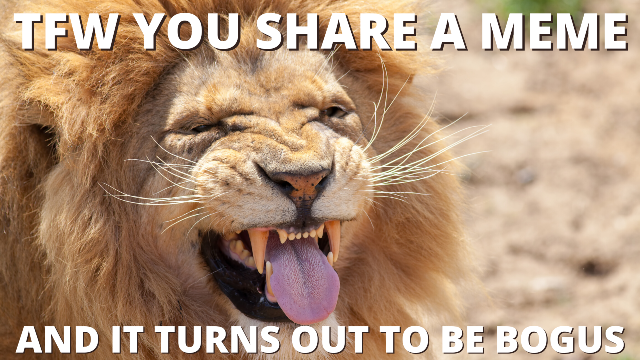Get Smart About Memes
Four strategies to decode messaging and motive in meme design.
 In the 2008 film The Dark Knight, Batman’s perpetual foil, the Joker, stands atop a mountain of burning money and declares, “It's not about the money. It's about sending a message.” That inspired the creation of countless internet memes with variations on the theme. Meme creators are often motivated to both make money and send a pointed message, and educators have found memes to be a valuable instructional tool. Whether we’re reminding kids about best practices for learning or having students use the format to demonstrate mastery of a concept, memes can be an effective, fun way to transform required content into bite-sized, easy-to-digest morsels. However, there’s another side to these ubiquitous online messages that should also be informing our news and information literacy instruction.
In the 2008 film The Dark Knight, Batman’s perpetual foil, the Joker, stands atop a mountain of burning money and declares, “It's not about the money. It's about sending a message.” That inspired the creation of countless internet memes with variations on the theme. Meme creators are often motivated to both make money and send a pointed message, and educators have found memes to be a valuable instructional tool. Whether we’re reminding kids about best practices for learning or having students use the format to demonstrate mastery of a concept, memes can be an effective, fun way to transform required content into bite-sized, easy-to-digest morsels. However, there’s another side to these ubiquitous online messages that should also be informing our news and information literacy instruction.
In 2019, an article about memes being used to recruit young white males to white supremacy groups caught our attention. Shortly thereafter, Stanford University historian and researcher Sam Wineburg used Twitter to trace the journey of a meme designed to spread racist propaganda. His analysis of how such memes play on emotions, perhaps most among readers who lack a basic understanding of history, was both fascinating and frightening.
During the COVID-19 crisis, we’ve seen a flood of memes that rely on similar tactics to stoke fears and spread misinformation, disinformation, and propaganda.
A recent study from the Pacific News Literacy Institute focusing on the news habits of college students revealed interesting trends, including that memes are a common and trusted source of information for young people.
Researchers found that memes, sometimes called “quick news,” can serve as lighthouses in a stormy sea of competing media, guiding readers to specific islands of information. One participant in the study summed it up this way: “That’s how I find out what's going on in the world, and what kind of stories I should be looking at." But with limited clues to authenticity, authorship, and source material, those islands can themselves be dangerous places. Couple this with the fact that meme accounts represent some of the most popular and successfully monetized spots on social media sites frequented by young people, like Instagram and TikTok, and, it’s clear that educators need to include memes in news and information literacy efforts.
Four lenses for digital detective work with memes
Today’s complex media and information landscape require all of us, but especially the kids we serve, to become digital detectives. We identified four key areas, or lenses, through which we think digital detectives should examine and dissect all forms of information. Here’s how those lenses might apply to memes.
🔎 Triggers: This lens refers to the emotional response that may be triggered by the words in the meme and by its design. Questions for digital detectives to consider:
○ How does the meme make you feel?
○ Do those feelings make you think the meme is targeted to specific individuals or groups of people?
○ How might the meme creators benefit from the viewer’s emotional response?
🔎 Access: This lens refers to the device used to access the meme. Some questions to consider:
○ What device are you viewing the meme on?
○ How does that device make it easier or harder to look up more information about the source?
🔎 Forensics: This lens refers to the digital clues that offer us hints about the purpose and credibility of the information. This is where learners can apply a traditional credibility protocol like the CRAAP test or CARS checklist. Questions to consider:
○ Who created the meme?
○ When was it published?
○ Can you triangulate it with other sources?
🔎 Motives: This lens refers to the potential motives of the meme creators. Questions to consider:
○ What would motivate someone to create this meme?
○ What response are they hoping to trigger?
○ How do they benefit if you like and/or share it?
Interactive image sites such as genial.ly and ThinglinkEDU are excellent tools for helping learners apply the four lenses to memes. Here’s an example using a popular meme used to spread misinformation during the COVID-19 crisis:

Link to interactive image here.
Another way to help kids think about choices made by meme creators is to have them make their own. California educators Ryan O’Donnell and Brian Briggs created this guide for helping students build memes using Google Slides. After that, they can annotate the memes to describe how they used the images and text to influence others is as easy as:
● Adding thoughts as comments
● Explaining them in the presenter notes
● Linking to an external Google doc
● Adding an audio or video file to the slide
We’ve created this analog version of the same activity for easy printing. If the technology proves to be a barrier in your teaching context, learners can complete this version by drawing a meme of their own.
Finally, what would an article about memes as potential vehicles for spreading false information be without a meme about that very thing?

If you or your students go meta and create memes about memes and media literacy, we’d love to see them! Please be sure to tag us (#FactvsFiction) when you share them on social media!
Jennifer LaGarde and Darren Hudgins are co-authors of Fact Vs. Fiction: Teaching Critical Thinking Skills in the Age of Fake News.
RELATED
The job outlook in 2030: Librarians will be in demand
The job outlook in 2030: Librarians will be in demand
ALREADY A SUBSCRIBER? LOG IN
We are currently offering this content for free. Sign up now to activate your personal profile, where you can save articles for future viewing





Add Comment :-
Comment Policy:
Comment should not be empty !!!